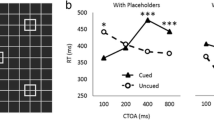Summary
Stoffer (1991) and Umiltá and Nicoletti (1992) have proposed an attention-shifting account of the Simon effect. However, Hommel (1993) has presented evidence suggesting that the effect can be explained in terms of referential coding, without invoking attentional shifts. Five experiments are reported here, whose primary purpose is to test implications of the referential-coding account. All of the experiments compared conditions in which a noise stimulus was presented in the position opposite the target stimulus with conditions in which it was not. Contrary to the referential-coding account, (a) the basic Simon effect was larger without a fixation point to serve as a referent than with one; (b) the noise stimulus increased the magnitude of the Simon effect when a fixation point was used, but not when there was no fixation point; and (c) the magnitude of the Simon effect obtained in the presence of a noise stimulus was reduced substantially when the noise and the target (and, if present, the fixation point) were in different colors. The results, although counter to predictions of the referential-coding account, can be accommodated by the attention-shifting account if it is assumed that a fixation point provides an anchor that minimizes attention shifts.
Similar content being viewed by others
References
Bundesen, C., & Pedersen, L. F. (1983). Color segregation and visual search. Perception & Psychophysics, 33, 487–493.
Grice, G. R., Canham, L., & Boroughs, J. M. (1984). Combination rule for redundant information in reaction time tasks with divided attention. Perception & Psychophysics, 35, 451–463.
Grice, G. R., Canham, L., & Gwynne, J. W. (1984). Absence of a redundant-signals effect in a reaction time task with divided attention. Perception & Psychophysics, 36, 565–570.
Hedge, A., & Marsh, N. W. A. (1975). The effect of irrelevant spatial correspondences on two-choice response time. Acta Psychologica, 39, 427–439.
Hommel, B. (1993). The role of attention for the Simon effect. Psychological Research/Psychologische Forschung, 55, 208–222
Kramer, A. E., & Jacobson, A. (1991). Perceptual organization and focused attention: The role of objects and proximity in visual processing. Perception & Psychophysics, 50, 267–284.
Lu, C.-H., & Proctor, R. W. (1994). Processing of an irrelevant location dimension as a functon of the relevant stimulus dimension. Journal of Experimental Psychology: Human Perception and Performance, 20, 286–298.
Nicoletti, R., & Umiltà, C. (1989). Splitting visual space with attention. Journal of Experimental Psychology: Human Perception and Performance, 15, 164–169.
Proctor, R. W., Lu, C.-H., & Van Zandt, T. (1992). Enhancement of the Simon effect by response precuing. Acta Psychologica, 81, 53–74.
Schneider, W., & Shiffrin, R. M. (1977). Controlled and automatic human information processing: I. Detection, search, and attention. Psychological Review, 84, 1–66.
Simon, J. R. (1990). The effects of an irrelevant directional cue on human information processing. In R. W. Proctor & T. G. Reeve (Eds.), Stimulus-response compatibility: An integrated perspective (pp. 31–86). Amsterdam: North-Holland.
Simon, J. R., & Rudell, A. P. (1967). Auditory S-R compatibility: The effect of an irrelevant cue on information processing. Journal of Applied Psychology, 51, 300–304.
Stoffer, T. H. (1991). Attentional zooming and spatial S-R compatibility. Psychological Research, 53, 127–135.
Theeuwes, J. (1991). Exogenous and endogenous control of attention: The effect of visual onsets and offsets. Perception & Psychophysics, 49, 83–90.
Treisman, A. (1986). Properties, parts, and objects. In K. R. Boff, L. Kaufman, & J. P. Thomas (Eds.), Handbook of perception and human performance, Vol. II: Cognitive processes and performance (pp. 35/1–70). New York: Wiley.
Treisman, A., & Gelade, G. (1980). A feature-integration theory of attention. Cognitive Psychology, 12, 97–136.
Umiltà, C., & Liotti, M. (1987). Egocentric and relative spatial codes in S-R compatibility. Psychological Research, 49, 81–90.
Umiltà, C. & Nicoletti, R. (1985). Attention and coding effects in S-R compatibility due to irrelevant spatial cues. In M. I. Posner & O. S. M. Marin (Eds.), Attention and performance XI (pp. 457–471). Hillsdale, NJ: Erlbaum.
Umiltà, C., & Nicoletti, R. (1990). Spatial stimulus-response compatibility. In R. W. Proctor & T. G. Reeve (Eds.), Stimulus-response compatibility: An integrated perspective (pp. 89–116). Amsterdam: North-Holland
Umiltá, C., & Nicoletti, R. (1992). An integrated model of the Simon effect. In J. Alegria, D. Holender, J. Junca de Morais, & M. Radeau (Eds.), Analytic approaches to human cognition (pp. 331–350). Amsterdam: North-Holland.
Verfaellie, M., Bowers, D., & Heilman, K. M. (1988). Attentional factors in the occurrence of stimulus-response compatibility effects. Neuropsychologia, 26, 435–444.
Wallace, R. J. (1971). S-R compatibility and the idea of a response code. Journal of Experimental Psychology, 88, 354–360.
Yantis, S., & Jonides, J. (1990). Abrupt visual onsets and selective attention: Voluntary versus automatic allocation. Journal of Experimental Psychology: Human Perception and Performance, 16, 121–134.
Author information
Authors and Affiliations
Rights and permissions
About this article
Cite this article
Proctor, R.W., Lu, CH. Referential coding and attention-shifting accounts of the Simon effect. Psychol. Res 56, 185–195 (1994). https://doi.org/10.1007/BF00419706
Issue Date:
DOI: https://doi.org/10.1007/BF00419706




